WORLD CLASS COACHING
4-2-3-1 Attacking
By Luca Bertolini
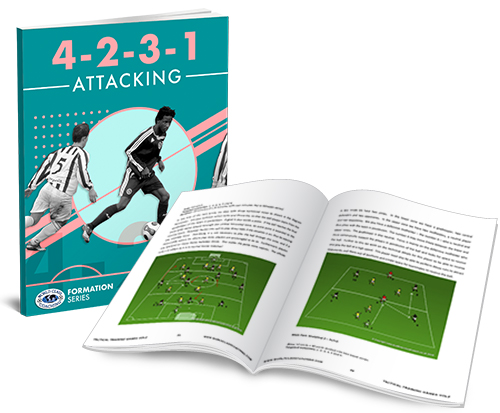
Table of Contents
PART THREE
Possession, Key Attacking Principles, Movements and Variations Without the Ball
Possession, Key Attacking Principles, Movements and Variations Without the Ball
The worst mistake we can make while setting the team up with the 1-4-2-3-1 is to consider as simple 1-4-2-1-3 while building up, with the winger who pushes up on the center forward line…
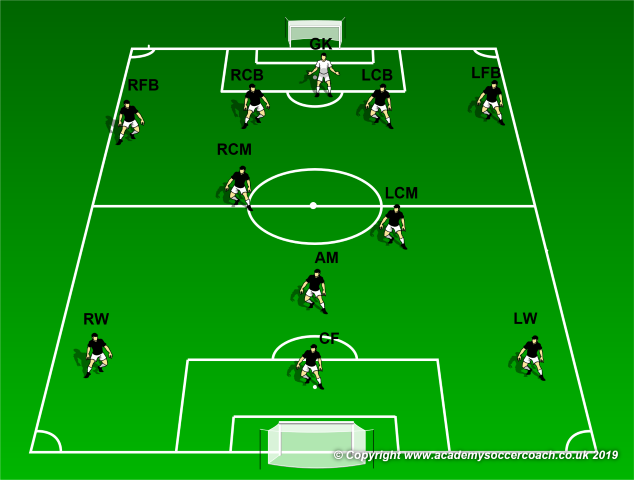
…and a 1-3-3-1-3 as attacking shape, with 1 fullback on the same line of the midfielders.
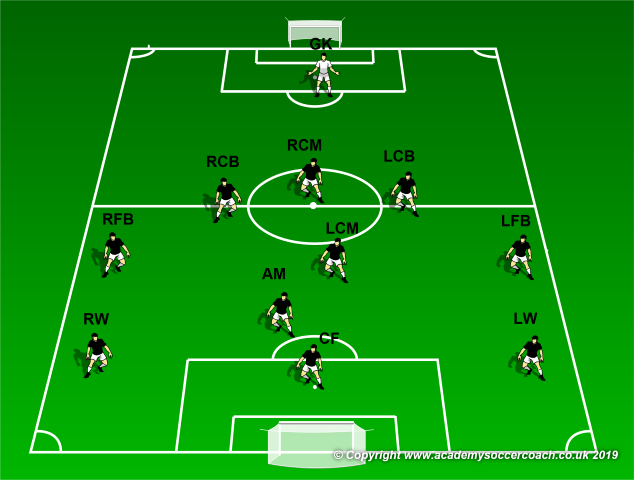
Guardiola and Manchester City analysis can help us to better understand how movements on and off the ball, key attacking principles are many more than we could think about; and 1-4-2-3-1 starting shape of the team helps all these variations.
This 1-4-2-3-1 is the team shape of the last Premier League match against Tottenham (17/08/2019):
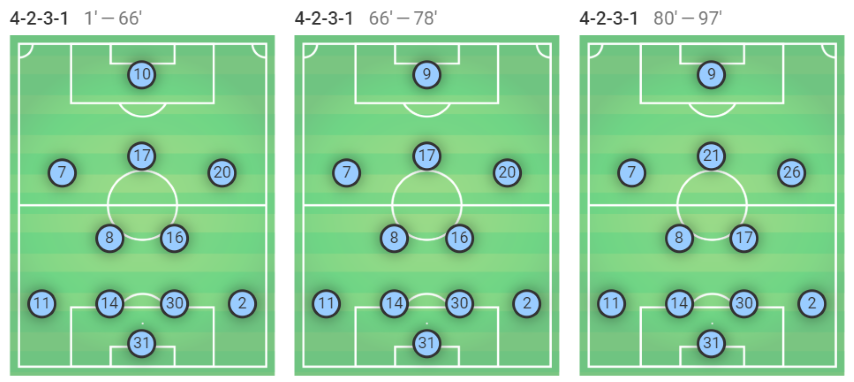
A four back line in front of Ederson (31): Walker (2) RFB, Otamendi (30) RCB, Laporte (14) LFB and Zichenko (11) LFB.
2 center midfielders: Rodri (16) and Gundogan (8).
3 advanced players: Sterling (7) LW, De Bruyne (17) ACM and Bernardo Silva (20) RW.
Aguero (10) as only CF.
Subs: Gabriel Jesus (9) as CF, Mahrez (26) RW and David Silva (21) ACM.
This is the team shape of the very first official match of this season against Liverpool (Community Shield, 04/08/2019)
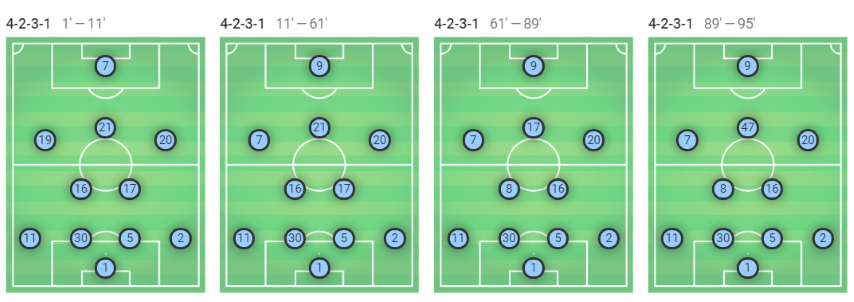
A four back line in front of Bravo (1): Walker (2) RFB, Otamendi (30) RCB, Laporte (14) LFB and Zichenko (11) LFB.
2 center midfielders: Rodri (16) and De Bruyne (17).
3 advanced players: Sanè (19) LW, David Silva (21) ACM and Bernardo Silva (20) RW.
Sterling (7) as only CF.
Subs: Gabriel Jesus (9) as CF, Gundogan (8) CM and Phil Foden (47) ACM.
Let’s now have a look at how many shape and possession and attacking developments City was able to carry out on the field during those matches, with a deeper focus on Premier League match against Tottenham, after a first example of the team positioning on the field to build up from the goalkeeper with the new rule, that allow possession players being inside the 18 y box and force the opponents to start out of the penalty box until the first pass is clearly played.
Building up from the back:
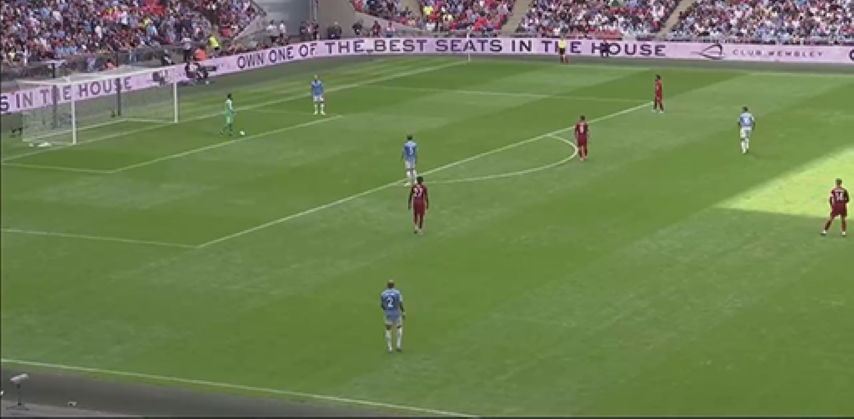
The first CB is placed very close to the goalkeeper, who is starting the move with a goal kick; the second CB is just out of the penalty area, from this side of the opposition pressure line; it’s quite clear how Liverpool aim is not to pressurize immediately the ball carriers, as the play is resumed.
One CM is played over the opposition pressure line as advanced target player.
Liverpool forwards try to overshadow the wide passing options and the CB, having the chance to put pressure against the 2nd CB out of the penalty area, who is turned toward the goalkeeper.
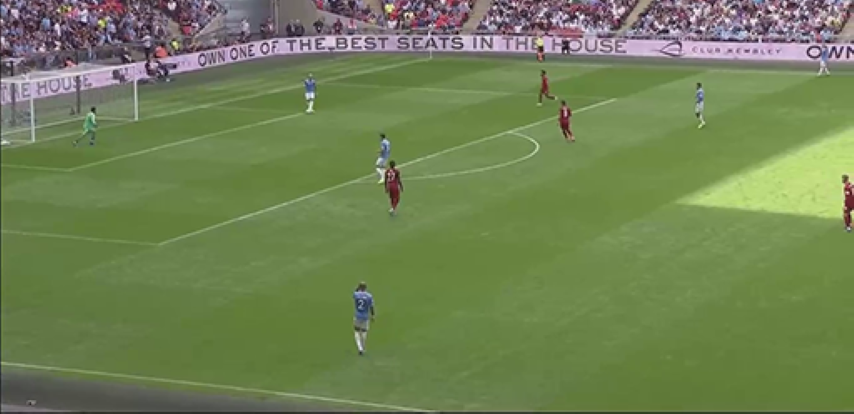
As the first CB receives, the goalkeeper acts as nearest and easiest option, to invite the opposition pressure. Only 1 opponent runs inside the penalty area, after the first pass.
Together with the RFB and LFB, a 2 (GK + 1st CB) + 1 (2nd CB) + 3 (RFB + 1st CM + LFB) v 3 situation is created
The GK receives the back pass, a second opposition forward runs inside the 18 y box and the nearest passing option can be easily countered…
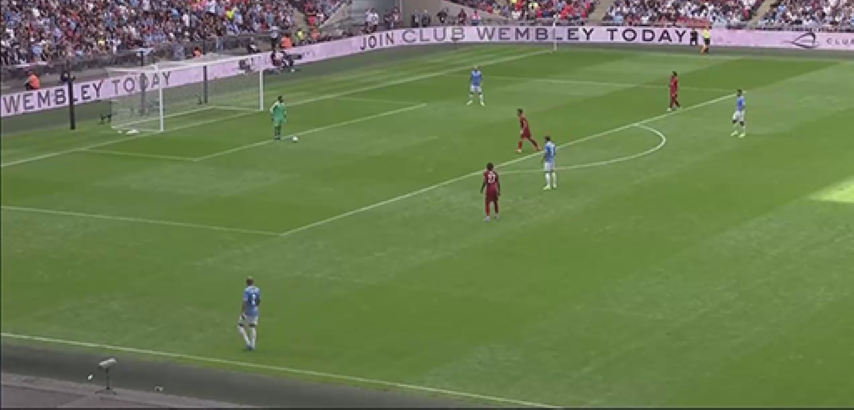
...The numerical advantage allows the CM to receive a pass that overcome the first line of pressure and to be able to turn and dribble the ball up the field
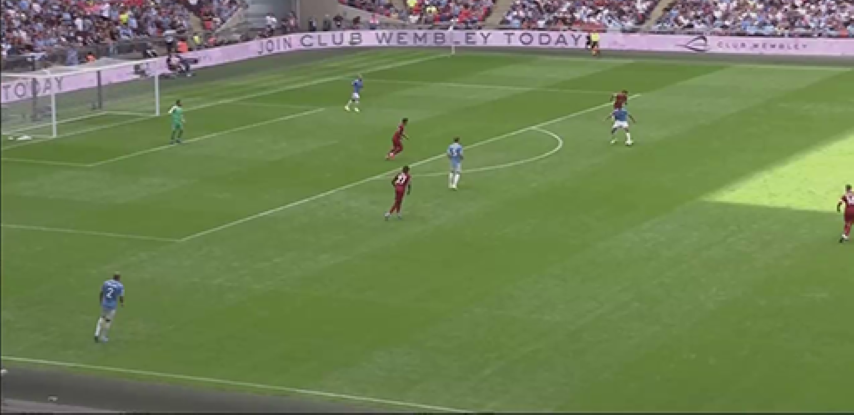
This is the main difference in CM’s role; before this new rule take effect, the holding midfielder was usually placed between the CBs out of the penalty area, too ensure numerical advantage together with the goalkeeper against opposition defensive pressure (usually a 3+gk v 2 or 3+gk v 2 duels were created).
As now it’s possible to create numerical advantage inside the penalty area and the first receiver is not immediately under pressure, the CM can help the team in overcoming the first pressure line and he allow the second CM to push up the field.
A 2-4 shape is created to build up from the back then; 1st CB drops back inside the penalty area, the 2nd move forward out of the penalty area to invite the opposition pressure toward him, FBs can move up and wide, and the 1st CM is free to move at the back of the pressure line.
The 1-4-2 has become a 2-4 to build up from the back.
If the first line of pressure is neutralized and the opposition shape is not properly narrow to allow the midfielders to counter the playing out phase of possession, then the defense line can be attacked with 5 players.
The LFB has the possession, the 2nd CM can push up and play on the same line of the 3 advanced teammates and the CAM can move toward the ball position to create numerical advantage against the opposition FB and outer CM, inviting the CB out of position.
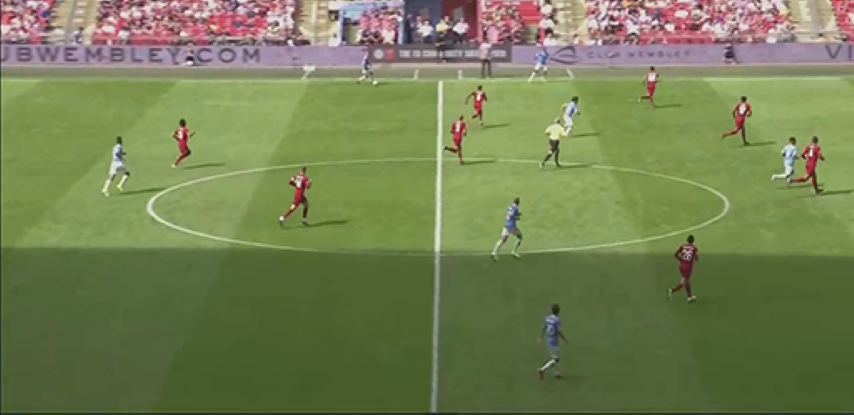
A 4-1 attacking line is then created in the middle third, where all the players can face the opposition goal.
From a 1-4-2-3-1 on paper, with 4 passes, a 2-4-4-1 is shaped to build up and to play out.
Playing out being already under pressure and forced to play backward:

When the opposition try to press the possession phase and it must built up again from the back, it’s important to create numerical advantage on the ball; the 1-4-2-3-1 allow to shape it easily on the field.
The CBs can help the goalkeeper easily (3 v 1) and the FBs can stay positioned on the same line of the CMs to shape a lower midfield line of 4.
If the opposition create numerical advantage in the center (2 v 3), the FBs must be positioned wide and the CMs between the opponents to prevent them from overshadowing them.
The easiest solution that 1-4-2-3-1 allows is to create a rhombus around the pressing opponents, when the opposition send two forward inside the penalty area (in these situations, 1-4-2-3-1 is very similar to 1-4-3-3):
• GK as lower vertex
• CBs as side passing options
• CM (the player who acts as holding midfielder) as upper vertex or target player
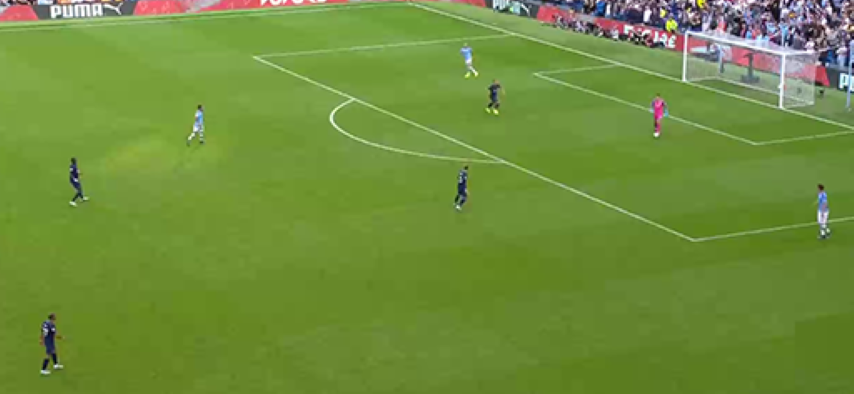
When the opposition looks to equalize the duels against the potential receivers (we can recognize a sort of 3 v 3 against the nearest passing options for the goalkeeper in possession, long passes can be played toward the FBs or wingers, who are usually placed wide and often up the field.
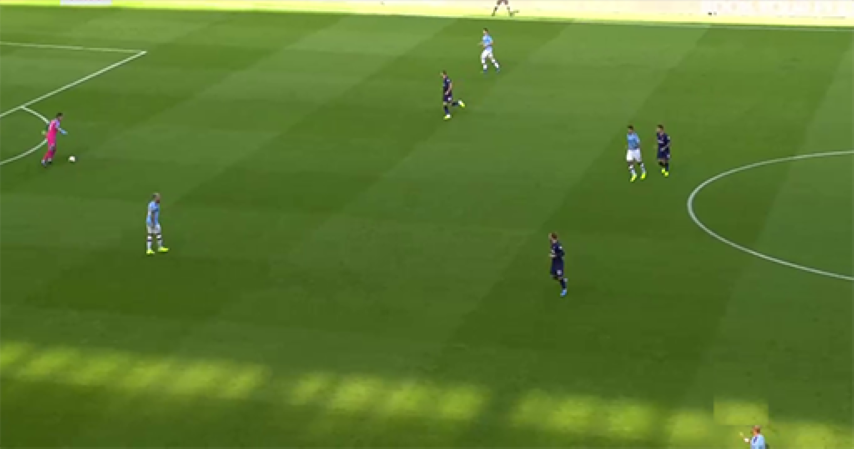
Two of three players in front of the goalkeeper are man marked (the holding midfielder) or easily under pressure, the LCB.
The RCB could receive and play out on the right, but it would the only possible solution; this way the third pressing player would already know where to direct the pressure action against the outer opponent.
For these reasons a long passes toward the wide wingers inside the opposition half or in the middle third are the best solutions; wide wingers can be positioned so high on the field, thanks to the overloading actions of the center first and middle thirds that force the opposition to maintain narrow distances among the players.
This situation, which led to a clear chance for Manchester City against Tottenham, is very explicative from this point of view:
• The opponents equalized the duel inside the defensive first third of City with goalkeeper in possession and all the three nearest passing options were marked and potentially under strong pressure. The 1-3 formation can’t be effective for possession team.
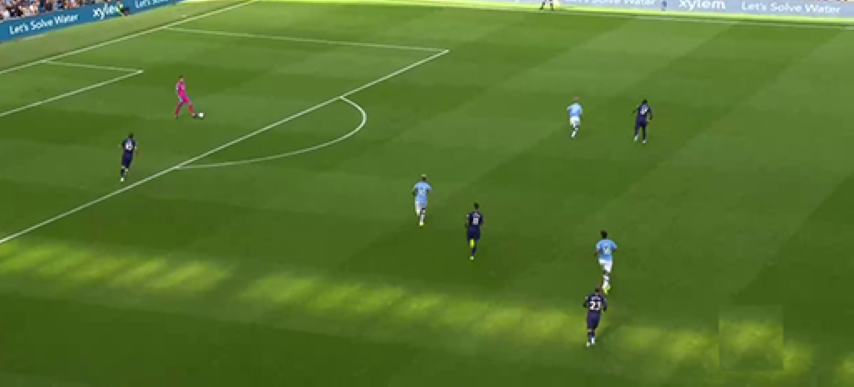
• Four advanced pressing players mean to be high on the pitch with all the team lines; but it’s not like that here, as the wide right winger headers for the blind run of the RFB and of the RAM shows; a 3 v 2 duel was created, to progress the move up the field. Two opponents tried to retreat their positions, but too much late to counter the goalkeeper pass receiver and the FB went out of position, opening a space behind him, where City FB could run onto.
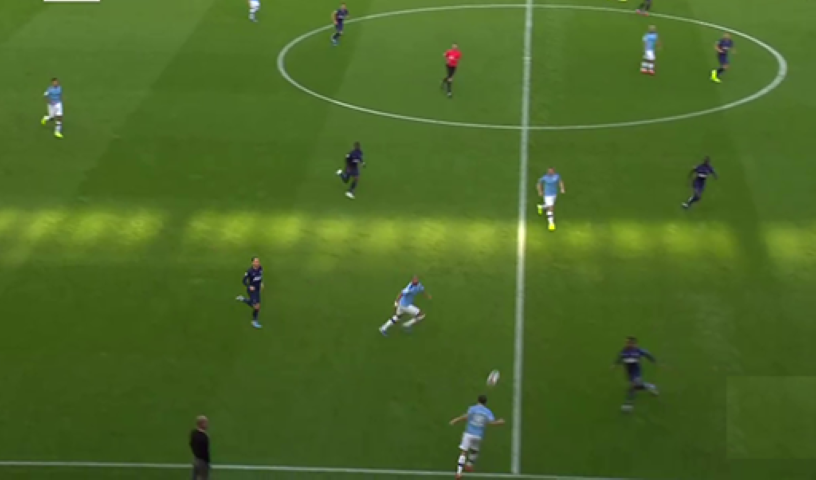
Overcoming the opposition pressure that aimed to counter the 1-3 City formation at the back, has allowed a 5-2 attacking shape for city, equalizing the duel inside the offensive half if we include the opposition goalkeeper and numerical advantage 7 v 6 if we do not include him. A 1-3-2-5 formation was shaped, with the fifth wide player (the RW) opened a space for the third right teammate.
• Looking at the final third more in more detail, 4 players were attacking 3 defenders and the goalkeeper; 1 v 1 duel on the ball, 2 v 2 duel in the middle, as the defenders were tracking City forwards and a back support for the team in possession.
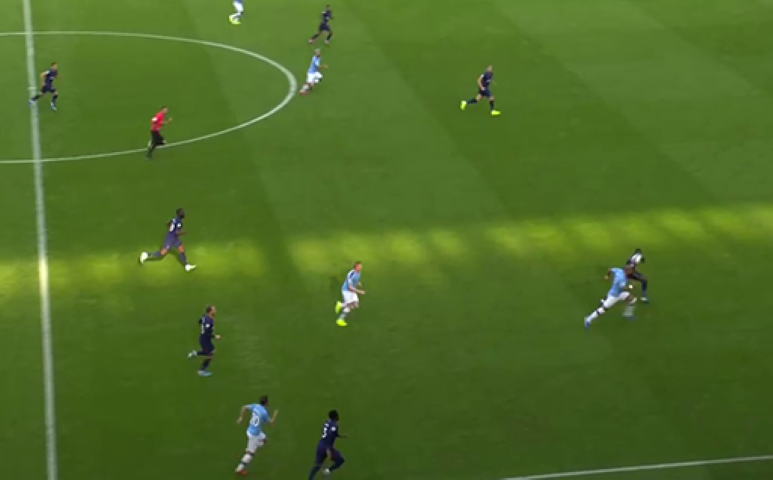
• The same situation could be found inside the opposition goal area with defenders who were not marking the opponents while the ball carrier was turning inside to play a cross pass.
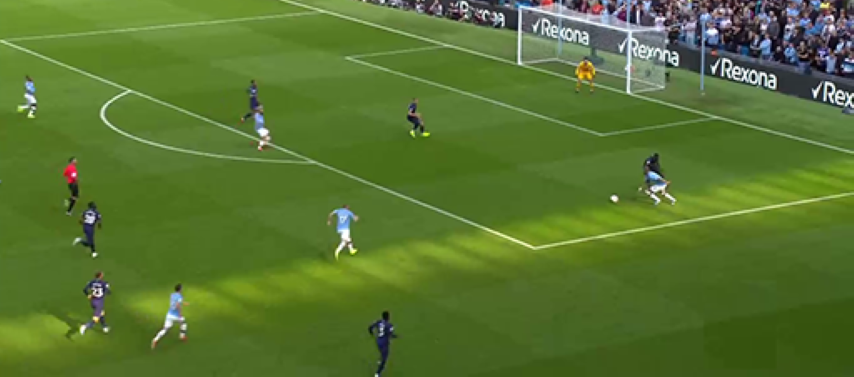
The opposite winger cut inside from the left side to attack the goal, the RAM ran forward to support the move, and the center forward was positioned inside zone 14, before RFB turned to receive a potential cut back pass.
The opposition defense was on late and stretched, despite being able to create numerical advantage inside the box; the opposite winger, who cut inside, could score quite easily.
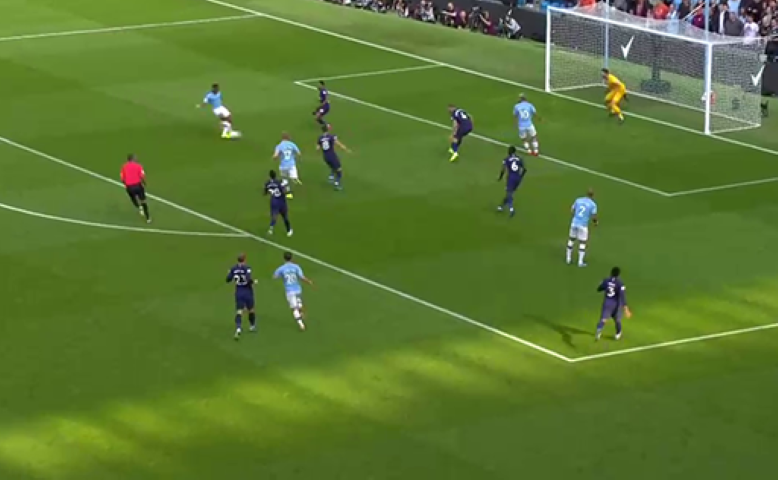
The 1-3-2-5 formation is clear in this following image; the line of 5 was made by the FB who ran up from the midfield line of 3.
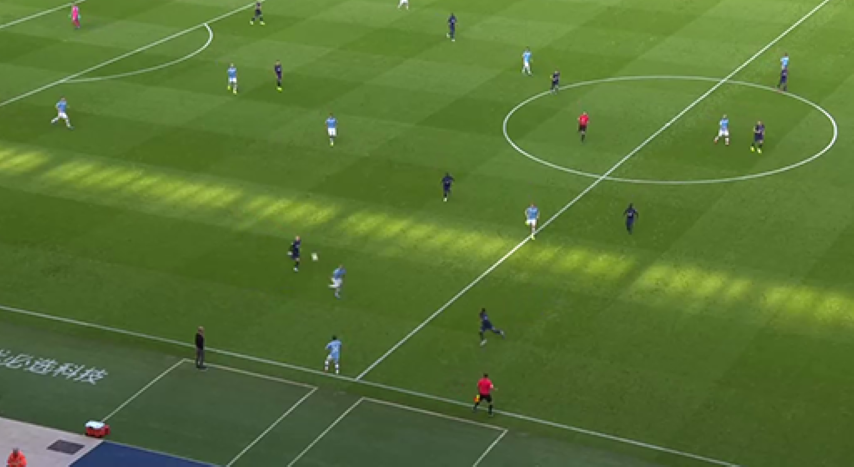
• From a 1-4-2-3-1 on paper, the RFB pushed up into the midfield line first, wingers and AM pushed up as well on the same line of the CF, creating a 1-3-3-4.
• The RFB ran forward and deeper without the ball to receive at the back of the opposition midfield line, shaping a line of 5 that attacked the opposition goal.
This is a similar situation that led Manchester City to score the first goal of the match.
The first 3 v 1 duel (GK + CBs) won the first 3 v 1 duel easily while building up from the back. Both FBs pushed up on the same line of the CMs, shaping a 1-2-4 formation.
Two pressing opponents were screening in front and covering at the back both center passing options; playing out on the left side was not possible as the LFB was man marked. The RFB could be soon under pressure while receiving, in case of being selected as target player of the playing out phase.
A 4 v 4 duel can be recognized in along the middle third line; this means that opposition had 5 advanced players inside the opposition half.
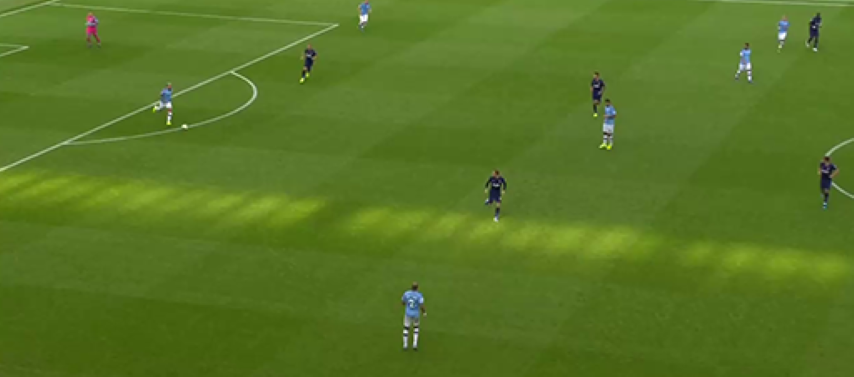
Long pass toward the wide winger was the best solution possible
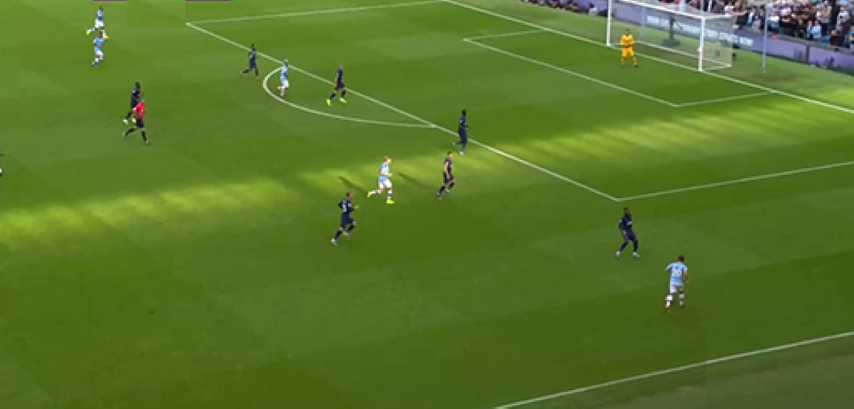
As the inverted right winger dribbled toward the opposition LFB, the LCM reached the advanced teammates line, shaping a 5 players attacking phase; all them were looking at the opposition goal, forcing the opponents to defend deeper.
A 1-2-3-5 formation was shaped on the field
The nearest players to the ball stayed placed behind the ball line, taking advantage of the depth defense of the opposition without pressure near the ball.
Despite a huge numerical advantage inside the box for the opposition, 3 defenders were positioned on the corner of the 18 y box, a fourth one on the first post and a 3 v 2 duel can be recognized on the second post of the goal, with 2 attacker completely free.
The back support player, who was unmarked inside the right half space was able to receive and send a cross pass behind the defense line toward the second post of the goal.
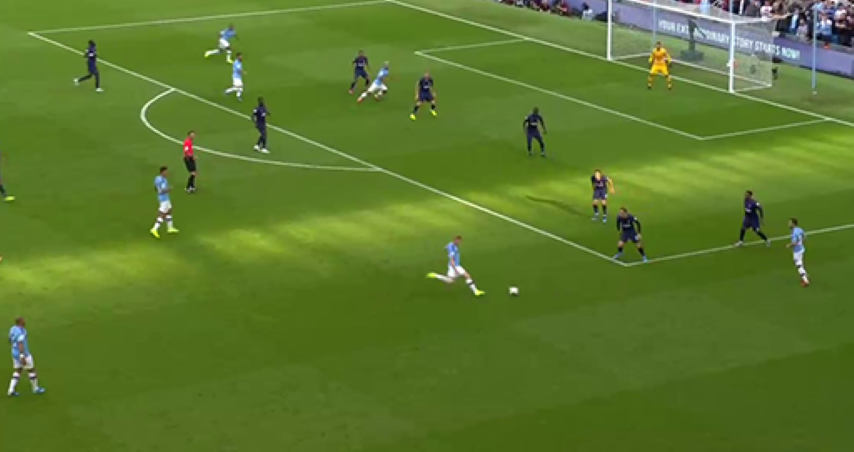
The opposite LW could receive unmarked and beat the goalkeeper easily.
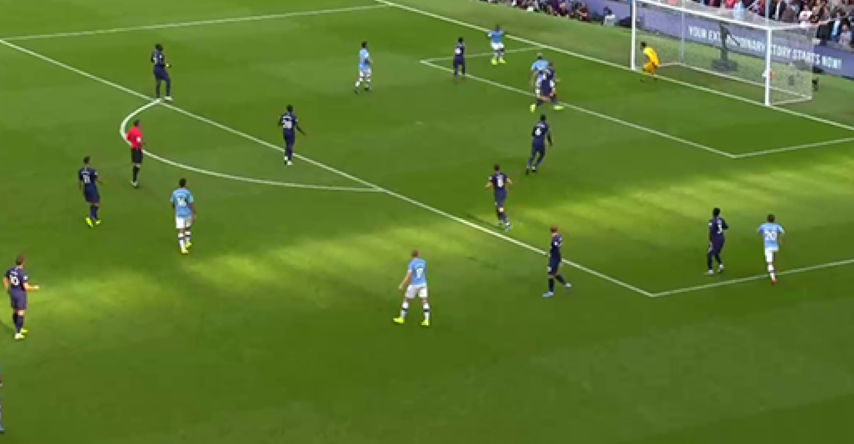
The last two situations of play show how 1-4-2-3-1 provides many attacking solution with few and short players’ movements.
• FBs pushing up to shape a 4 player middle third line
• Wingers pushing up and wide to receive freely as the center was overload by the advanced players and then made even more condensed by the CMs
• Opposite winger who can play as CF inside the box to finish.
As we analyzed in the first part of this book, the main advantage of this system of play is that it allows the creation of numerical advantage along the half spaces and near the ball with few movements off the ball.
This situation is very explicative to understand how many possible solutions the 1-4-2-3-1 can provide to the team:
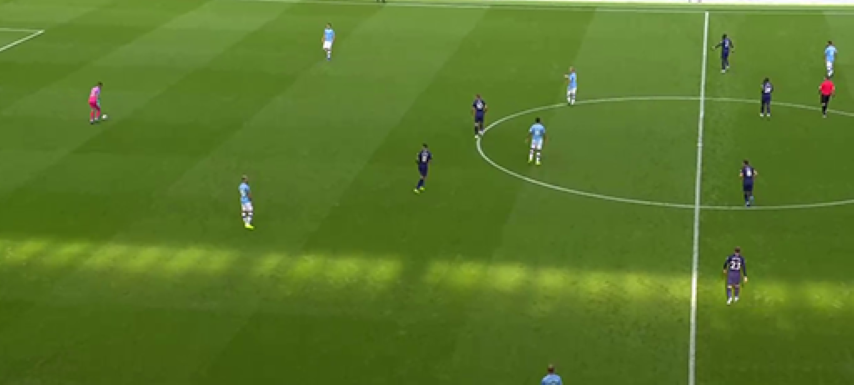
• The GK has the possession, the CBs are free to receive, but two opposition forwards are screening the passing lanes to the CM (the left one is an inverted fullback).
• The LFB has moved toward the center beside the RCM.
• The LCM has pushed forward.
• The RFB is placed wide.
• Four opposition midfielders are positioned narrow in the middle third are forced to cover the passing lanes toward the four advanced players; if just one of them would cover a wide passing lane, a paths toward the final third would be opened.
• The final third can be reached easily anyway, thanks to a long pass to the wide wingers; the four advanced attackers would have the support of a fifth teammate (the 2nd CB).
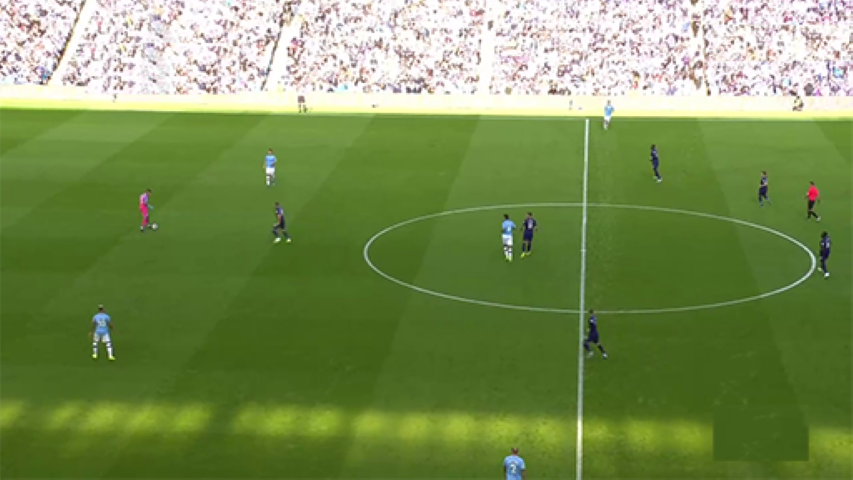
• The GK has the possession, the CBs are free to receive, but two opposition forwards are screening the passing lanes to the holding midfielder and man-marking him also.
• The FBs have moved wide on the left and on the right sides.
• The 2nd CM has moved forward to create a line of 5 attacking players along the last defense line (winger as wide as possible, as usual).
• Four opposition midfielders are again positioned narrow in the middle third and they are forced to cover the passing lanes toward five advanced opponents, who have the numerical advantage; if just one of them would cover a wide passing lane, a paths toward the final third would be opened.
• The final third could be reached easily anyway, thanks to a long ground pass to the FBs or a high areal pass to the wide wingers; the four advanced attackers would have the support of a fifth teammate (the 2nd CB).
In this last example, the RCB has the possession in the middle third and seven players are positioned throughout the attacking half
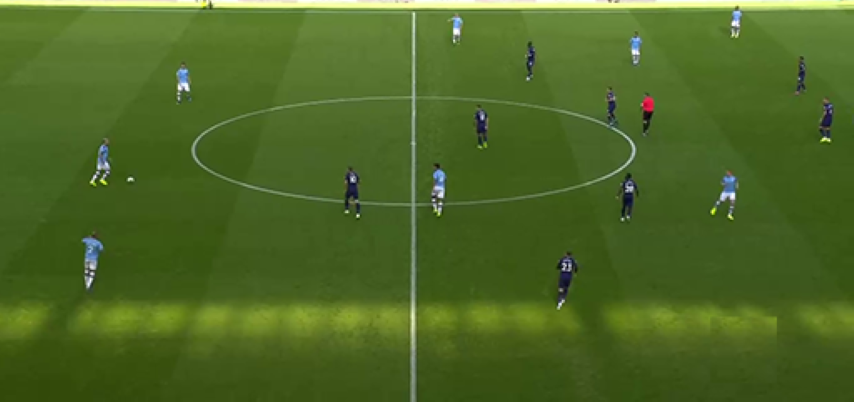
• The RFB complete the line of 3 at the back
• The LFB is positioned wide on the left side and the LW in front of him
• The holding midfielder is being overshadow, but again, five attacking players shape a 2 (CM + AM) +3 (LW + CF + RW) advanced formation.
A 1-3-2-2-3 formation is shaped.
The 2 main principles of play inside the final third of Guardiola’s 1-4-2-3-1 are:
1. Condense the center to open up spaces down the flanks (left side in this example); as the left fullback is pushing up along the flank, the advanced midfielders plays very narrow (one is dribbling the ball up, the second one takes place along the forwards’ line, forcing the opponents to create a strong area around them looking for numerical advantage (3 v 2) and opening a space along the left flank.
Meanwhile, the wingers move inside the center of the final third just inside the box, forcing the opposition back four to get narrow to ensure numerical advantage again (4 v 3), opening a potential space along the right flank also. The opposite right fullback acts as inverted fullback to provide balance behind the ball area.
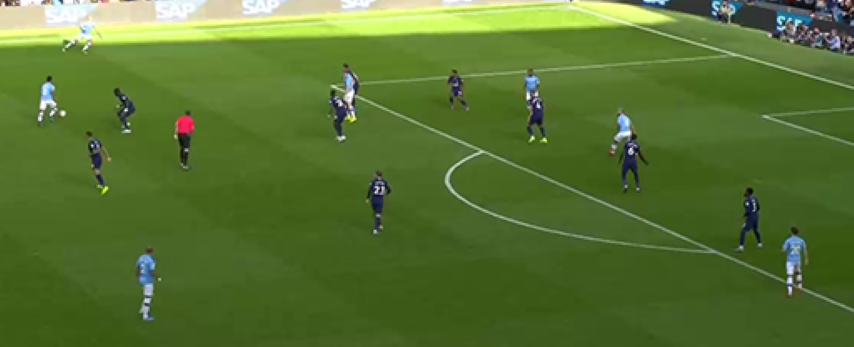
2. Overload one side to create a strong area around the ball and a weak side in the final third. In this situation, the left fullback is dribbling the ball up along the left flank, and the advanced midfielders are positioned up to him, as well as the holding midfielder has shift across toward the ball area; a 4 v 4 duel is created around the ball. The inverted right fullback provides balance again in the center.
The opposition back four are very narrow to save the box against the forwards (the left winger is positioned inside zone 14 to create a space along the flank that one midfielder can exploit to overcome the opposition pressure against the ball carrier and to win the 4 v 4 duel) and two midfielders are also screening them.
This way, the left attacking flank and side is overload by the opposition and the right attacking flank maybe exploited to switch the side of play.
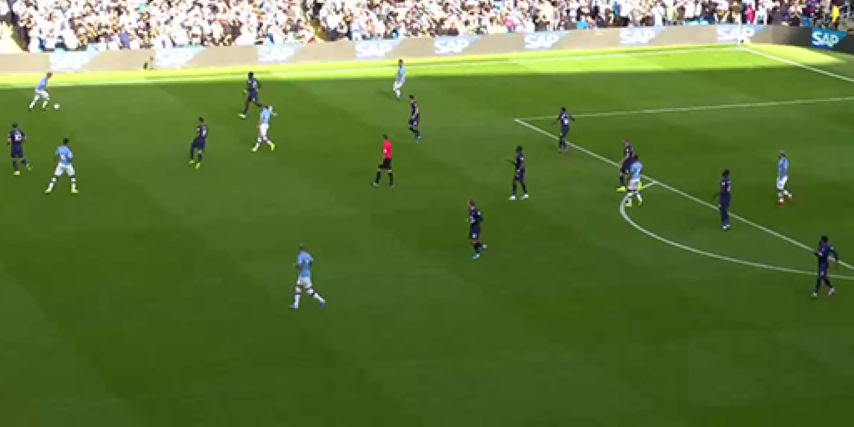
We can take a look to Guardiola’s Manchester City to have a 1-4-2-3-1 positional play example, analyzing the movements of the players to create an attacking move.
1. The left center back is dribbling the ball up along the left side of the middle third and the left fullback has pushed up off the ball to create space for the teammate in possession; the second center back and the opposite right fullback together with the holding midfielder create the balance triangle at the back.
The advanced midfielders are positioned as back support options for the forwards; a line of for attacking players is shaped along the opposition back line that is forced to look at the right defense side, freeing the right attacking winger.
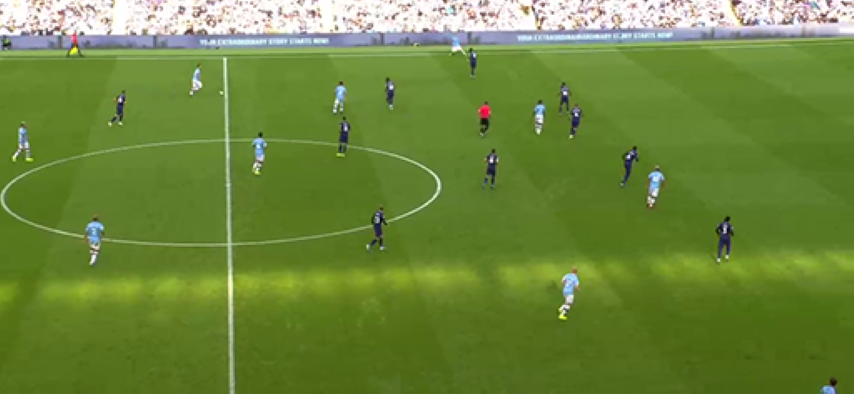
2. As the left fullback receives, a 3 v 3 duel is created as the opponents try to avoid any forward passing combination; 1 v 1 on the ball, the center back is tracked while he is trying to underlap along the flank and the support midfielder would be potentially under pressure quickly if he should have to receive a pass.
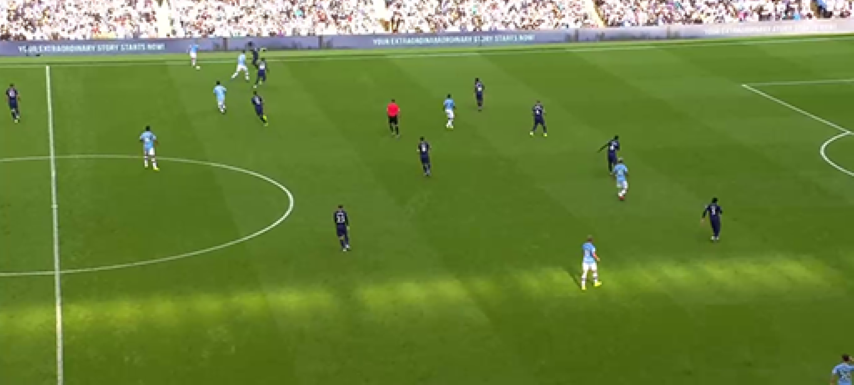
To summarize the main movements of this first two points, we may say that:
• The left center back is dribbling the ball up the left flank
• The left fullback is moving forward off the ball to create space
• The opposite fullback shifts across the center to create a balance tringle at the back
• One advanced midfielder moves toward the ball to be an option and ensure at least numerical equality near the ball
• The second advance midfielder move up toward the forwards’ line
• The opposite right inverted winger provide width along the opposition weak side
3. The support midfielder from the center receive and he is under immediate pressure; the upper midfielder understands it as well as the left fullback, who moves back to provide a safe passing option; the movement of his direct marker toward the ball allows him to be free at the back.
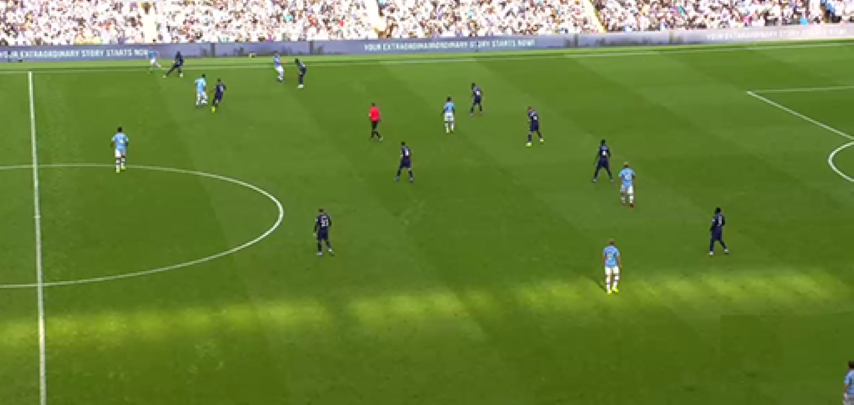
4. The ball carrier has two option to play out from pressure area and he chooses to play forward to the advanced teammate who turned his body position toward him to receive; again the left fullback moves at the back of his prior direct marker, who is looking at the ball again.

These are the main points to pay attention to:
• The opposition is able to prevent the possession players from moving the ball forward, but through positional play they were able to play out from the pressure area.
• Moving and passing combination have created a strong area on the ball, and forced the defenders’ body positioning toward the ball and the left flank (defense right side); this way the attacking right winger is completely free along the right side.
• The left winger and the right advanced midfielder force the opposition back line to get narrow in the center.
5. A back pass out of the defense triangle is enough to play out from the pressure area. It is very important to notice that the moving/passing combination has forced the opposition to shift across the ball area, creating a weak side along the opposite attacking right flank.
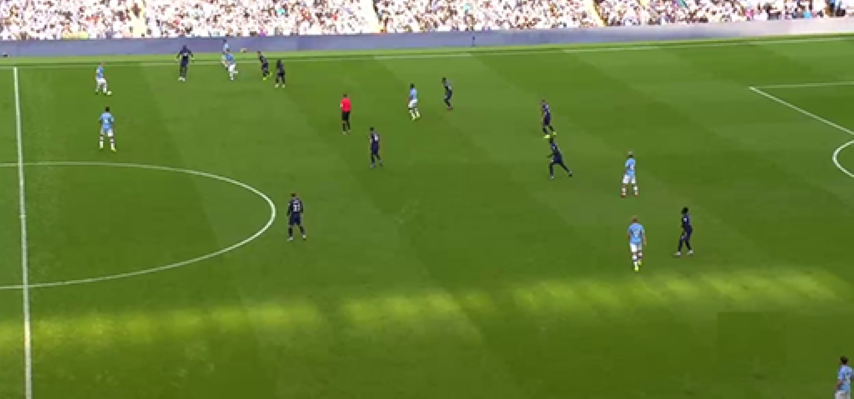
6. At this point it is very simple to allow the holding midfielder to receive and switch the side toward the attacking right flank; the 5 – 4 opposition defense shape is very narrow throughout the center right side and the weak area must be covered as quickly as possible to prevent the opposition inverted right winger from receiving and dribbling toward the box. The attacking line of four players make the defense of the weak side risky, as a potential 4 v 4 duel maybe created inside the box.
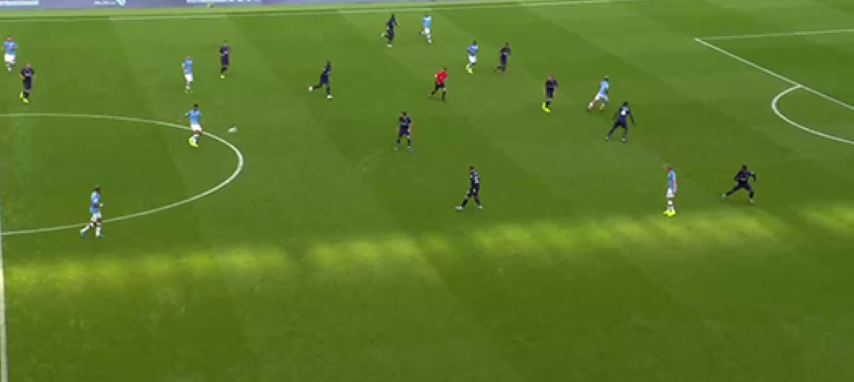
These are the main points to pay attention to:
• The left fullback drops back to be a safe passing option first and then toward the center to replace the position of the advanced left midfielder who is now positioned as left winger.
• The holding midfielder get closer to the ball position to be a passing option to play out from the pressure area and to switch the side of play
• The midfield line is now shaped by holding midfielder and the fullbacks
• The right advanced midfielder pushes up along the attackers’ line in the center, creating a potential 4 v 4 duel if the right winger receive and the fifth opponent is forced to run out to close him
• The center back drops deep to be positioned properly, shaping a 2 + 3 back formation, as five attacking players are positioned along the opposition back line


